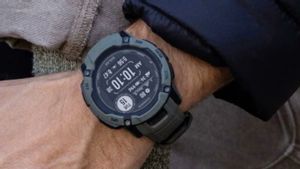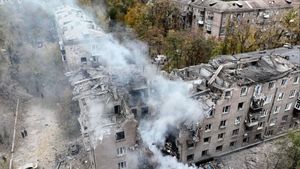JAKARTA - The 115-foot solar-powered drone built in the UK has made its first successful flight to the stratosphere - the second layer of Earth's atmosphere. This drone can operate in the air for 20 months.
During the 24-hour period, PHASA-35 took off from New Mexico and flew for more than 66,000 feet, officially reaching the stratosphere, before landing successfully.
The 150 kg solar-powered aircraft, which has a wingspan covered with solar panels, has been developed by London company BAE Systems, at their facility in Warton, Lancashire.
This solar electric plane is run by solar power during the day and batteries at night, allowing it to fly for more than a year in the stratosphere, lower than most satellites.
PHASA-35 is bridging the gap between air and space 🛰️Over a 24-hour period, PHASA-35 soared to more than 66,000ft, reaching the stratosphere, before landing successfully.Find out more: https://t.co/vot1sXVhb2 pic.twitter.com/ED5rrOoAfh
— BAE Systems Air (@BAESystemsAir) July 14, 2023
PHASA-35 is bridging the gap between air and space 🛰️Over a 24-hour period, PHASA-35 soared to more than 66,000ft, reaching the stratosphere, before landing successfully.Find out more: https://t.co/vot1sXVhb2 pic.twitter.com/ED5rrOoAfh
PHASA-35 can carry up to 15 kg of payload, including cameras, sensors, and communication equipment to allow troops to communicate with each other or provide internet access to rural areas during natural disasters or emergencies.
The aircraft also has the potential to be used in communications network shipments including 4G and 5G, such as in areas that currently have poor range.
BAE Systems says PHASA-35 will be available in the middle of the decade and provides a 'permanent and affordable alternative' to satellite technologies that are usually heavier.
The PHASA-35 weighs 150 kg, approximately the same as the weight of a panda and only a small part of most satellites that usually weigh thousands of kg.
Developed in collaboration with engineers from the Hampshire, Prismatic, PHASA-35 companies will have various uses including 'observation of ultra-long intelligence, surveillance, and recognition, as well as security'.
"This team is really working on this mission," said Dave Corfield, CEO of Prismatic, as soon as launch, quoted by MailOnline. "PHASA-35's first stratosphere flight shows that this vehicle is on track to be the system of choice for long-lasting applications, high altitude, and future communications."
The construction of the drone began in 2018 along with the release of a concept image, after the successful launch of a quarter-scale model known as PHASE-8 in 2017.
The full version of the PHASA-35 has made its inaugural flight in February 2020, when it flew from the Woomera Test Range in South Australia.
The first flight to the stratosphere - the highest altitude PHASA-35 has ever achieved and is approaching its maximum altitude of around 70,000 feet - occurred on June 25 and was announced by the company on Friday, July 14.
The plane flew from the Whitekungan Missile Range, the US Army military testing area and shooting site located in New Mexico.
BAE Systems says this is the "first test flight of a series of tests" planned to confirm the aircraft's performance before it can be marketed.
اقرأ أيضا:
Engineers saw several core applications for these drones in areas normally covered by satellites in low Earth orbit, such as environmental monitoring, disaster relief, border protection, maritime and military surveillance, and mobile internet communications.
One example is his ability to install sensors, fly over vulnerable forests for months, and constantly monitor humidity levels in trees - with the ability to predict a few weeks earlier when fires might occur.
According to Prismatic, PHASA-35 can provide services with'small fees from satellites' and can be implemented anywhere, such as commercial drones.
The aircraft can only be launched when the wind and air conditions are right, but because of its ability to stay in the air for more than a year, some drones can be launched at once and stay ready to use when needed.
Because it operates in the stratosphere, above weather issues such as wind and rain, the aircraft can provide stable observations of certain areas for a long period of time.
"Other key benefits include the simplicity of construction and ease of transportation, as the relatively low number of structures forms the overall assembly of aircraft," Prismatic said.
The English, Chinese, Japanese, Arabic, and French versions are automatically generated by the AI. So there may still be inaccuracies in translating, please always see Indonesian as our main language. (system supported by DigitalSiber.id)














